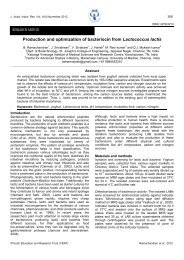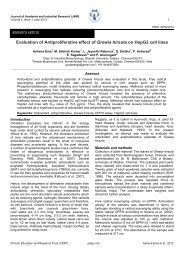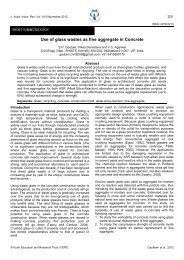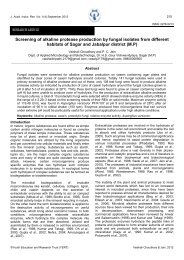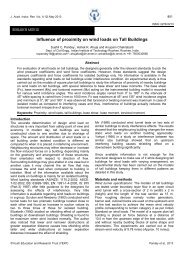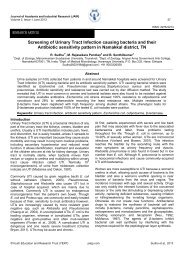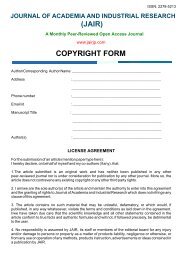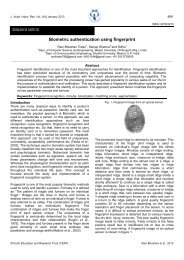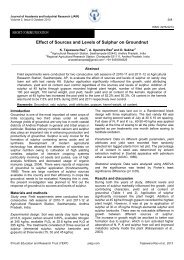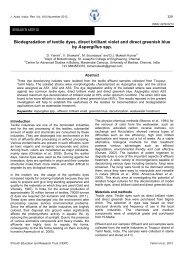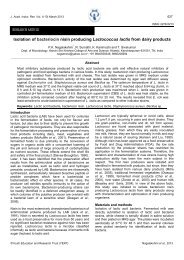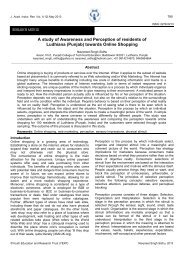Seed borne fungi of rice from South Tamil Nadu
Seed borne fungi of rice from South Tamil Nadu
Seed borne fungi of rice from South Tamil Nadu
You also want an ePaper? Increase the reach of your titles
YUMPU automatically turns print PDFs into web optimized ePapers that Google loves.
J. Acad. Indus. Res. Vol. 1(10) March 2013 613Table 2. Pathogen associated with discolored <strong>rice</strong> grains.VarietyPercentage <strong>of</strong> associationA. niger A. flavus Alternaria padwickii Penicillium citrinum Rhizopus oryzaeKarnataka Ponni 16.24 18.00 17.50 6.00 2.00Athisaya Ponni 16.00 15.00 8.00 4.25 0.00Culture Ponni 15.00 13.00 14.28 8.25 7.50Chellam Ponni 12.00 12.50 8.25 4.75 1.60ADT39 17.60 9.25 11.25 5.25 2.50The frequency <strong>of</strong> fungal association and occurrence wasvaried in different varieties <strong>of</strong> <strong>rice</strong> seeds. Earlierobservations reported the occurrence <strong>of</strong> Pyriculariaoryzae, Alternaria alternata, A. padwickii,A. longissima, Curvularia oryzae, C. lunata, Drechsleraoryzae, A. niger, Fusarium moniliforme, F. semitectum,F. oxysporum, F. solani and species <strong>of</strong> Phoma,Cercospora, Chaetomium, Sclerotium, Penicillium,Myrothecium and Colletotrichum <strong>from</strong> seeds <strong>of</strong> differentvarieties <strong>of</strong> <strong>rice</strong> (Khan, 2000; Wahid et al., 2001; Javaidet al., 2002; Nguefack et al., 2007). In this study, it wasobserved that Aspergillus niger, A. flavus, Penicilliumcitrinum, Alternaria padwickii and Rhizopus oryzaepresence in the seeds <strong>of</strong> different <strong>rice</strong> varieties.In Karnataka Ponni, highest percentage (18%) <strong>of</strong>A. flavus association was observed. Aspergillus nigershowed 17.6% <strong>of</strong> occurrence in ADT39 followed by17.5% in Karnataka ponni.The fungal association with the selected <strong>rice</strong> varieties isdepicted in Table 2. Suleiman and Taiga (2009) reportedfungal pathogen as the major cause <strong>of</strong> reduction in thequality <strong>of</strong> stored <strong>rice</strong> when insects and rodents arecontrolled. Rice growing in the field is contaminated withnumerous <strong>fungi</strong> which include <strong>rice</strong> blast caused byMagnaporthe grisea, <strong>rice</strong> sheath blight caused byRhizoctonia solani, brown spot caused by Cochlioblusmiyabeanus and false smut caused Ushlaginoidia virens(Nguefack et al., 2007). Stored <strong>rice</strong> grains are prone t<strong>of</strong>ungal attack, especially at a moderate temperature andhigh humidity. Spoilage <strong>of</strong> stored <strong>rice</strong> is attributed tostorage <strong>fungi</strong> which were introduced during thepost-harvest handling process (Javaid et al., 2002).In this study, Aspergillus niger was isolated <strong>from</strong>3 samples collected <strong>from</strong> 3 major markets <strong>of</strong> the studyareas. This confirms that the fungus is widely associatedwith unmilled <strong>rice</strong> grain and in storage which may resultin deterioration in form <strong>of</strong> discoloration and bad odorsmay occur with reduction in milling yield due to partlygrowth <strong>of</strong> mould and other microorganisms. The isolatedfungus was associated with stored <strong>rice</strong> with varyingfrequencies in the 5 localities sampled (Table 2).Presence <strong>of</strong> Aspergillus spp., especially A. niger andA. flavus on seeds <strong>of</strong> <strong>rice</strong> in higher frequencies and itsassociation with ungerminated seeds <strong>of</strong> <strong>rice</strong> confirmedthat species <strong>of</strong> Aspergillus though occur as saprophytesmay cause low germination in seeds. A number <strong>of</strong> <strong>fungi</strong>isolated in this study are known to produce mycotoxinswhich are harmful for human health.Mycotoxins can cause severe damage to liver, kidneyand nervous system <strong>of</strong> man even in low dosages(Rodricks, 1976). Aspergillus spp. are common fungalcontaminants <strong>of</strong> cereals and also produces mycotoxins(Bakan et al., 2002; Toth and Teren, 2005). Aspergillusflavus produces aflatoxins which were carcinogenic andproduce liver cancer (Purchase, 1974; Diener and Davis,1969; Pesta and Bonday, 1990). So, <strong>from</strong> the study, it isnoted that there is a need for proper storage <strong>of</strong> <strong>rice</strong> seedto minimize the fungal infestation and mycotoxinproduction during storage and provide disease freeseeds for human consumption. This study also revealsthe presence <strong>of</strong> diverse myc<strong>of</strong>lora <strong>of</strong> both pathogenicand non-pathogenic <strong>fungi</strong> in <strong>rice</strong> seeds in ruling varietiesand hybrids in <strong>Tamil</strong> <strong>Nadu</strong>.ConclusionFive pathogenic <strong>fungi</strong>, namely Aspergillus flavus,A. niger, Penicillium citrinum, Alternaria padwickii andRhizopus oryzae were isolated <strong>from</strong> different varieties <strong>of</strong><strong>rice</strong> seeds. The study revealed the presence <strong>of</strong> diversemyc<strong>of</strong>lora <strong>of</strong> both pathogenic and non-pathogenic <strong>fungi</strong> in<strong>rice</strong> seeds in ruling varieties and hybrids in <strong>Tamil</strong> <strong>Nadu</strong>.To conclude, the findings suggest that there is a need forproper storage <strong>of</strong> <strong>rice</strong> seed to minimize the fungalinfestation and their mycotoxin production in near future.References1. Bakan, B., Richard, D., Molard, D. and Cahagnier, B. 2002.Fungal growth and Fusarium mycotoxin content in isogenictraditional maize and genetically modified maize grown inFrance and Spain. J. Agri. Food Chem. 50(4): 278-731.2. Barnett, H.L. and Hunter, S.B. 1972. Illustrated genera <strong>of</strong>imperfect <strong>fungi</strong>. Minnesota. Burgess Publications. p.241.3. Diener, U.L. and Davis, N.D. 1969. Relation <strong>of</strong> environmentto aflatoxin production <strong>from</strong> Aspergillus flavus. In: Aflatoxin.(Ed.): L.A Goldblatt Academic Press. New York. pp.15-34.4. ISTA (International <strong>Seed</strong> Testing Association). 1993.International rules for seed testing. Rules amendments.<strong>Seed</strong> Sci. Technol. 29: 1-127.5. Javaid, M.S., Wahid, A. Idrees, M., Gill, M.A. and Saleem,A. 2002. <strong>Seed</strong> myc<strong>of</strong>lora studies in <strong>rice</strong>. Pak. J.Phytopathol. 14: 132-134.6. Khan, T.Z., Gill, M.A. and Khan, M.G. 2000. <strong>Seed</strong> <strong>borne</strong><strong>fungi</strong> <strong>of</strong> <strong>rice</strong> <strong>from</strong> central Punjab and their control. Pak. J.Phytopathol. 12: 12-14.7. Nguefack, J., Nguikwie, S.K. and Fotio, D. 2007. Fungicidalpotential <strong>of</strong> essential oils and fractions <strong>from</strong>Cymbopogon citratus, Ocimum gratissimmum andThymus vulgaris to control Alternaria padwickii andBipolaris oryzae, two seed-<strong>borne</strong> <strong>fungi</strong> <strong>of</strong> <strong>rice</strong> (Oryzasativa L.). J. Essential Oil Res. 17: 581-587.©Youth Education and Research Trust (YERT) Uma & Wesely, 2013



